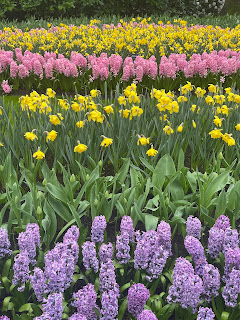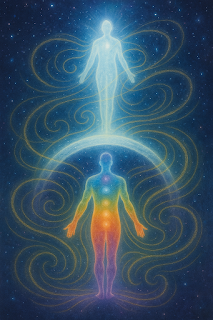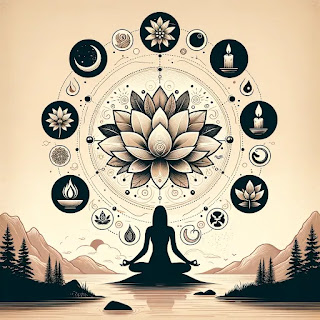Observing Sensations: The Body as a Gateway to Insight
How Direct Awareness of Sensation Deepens Vipassana Meditation

In our first article, The Art of Seeing Clearly, we explored Vipassana as the practice of insight, a meditation that reveals the true nature of reality through direct observation. Now, we step deeper into the heart of this practice by focusing on the body. It is here, in the ever-changing landscape of physical sensations, that the path of wisdom begins to unfold.
Many people approach meditation with the idea that it’s about calming the mind. While this is partly true, Vipassana offers something more profound. It teaches that by observing the subtle sensations within the body, we can see directly how impermanence, suffering, and the illusion of self operate within us. This awareness brings insight, and insight brings freedom.
Why the Body Matters in Vipassana Practice
The Buddha’s original teachings, preserved in texts like the Satipatthana Sutta, begin with mindfulness of the body. This is not accidental. The body is our most immediate and accessible field of experience. Thoughts are slippery and abstract, but sensations are concrete. They are felt right here and now.
When we bring attention to bodily sensations, we anchor ourselves in the present moment. Each sensation — whether it is warmth, coolness, pressure, tingling, itching, or pain — carries a message. By observing without reacting, we begin to understand the fundamental truth that everything is in constant flux. No sensation stays the same for long. This direct experience of change, known as anicca (impermanence), becomes the foundation for deeper insight.
The Hidden Power of Sensation Awareness
At first, observing sensations may seem simple. But over time, it reveals layers of conditioning we didn’t even know existed. Every time we feel a pleasant sensation, the mind wants more. Every time discomfort arises, the mind wants to push it away. This cycle of craving and aversion is the engine that drives much of our suffering, known in Buddhism as dukkha.
By training ourselves to simply observe sensations without clinging or resisting, we gradually weaken these unconscious patterns. A pleasant warmth passes through the body, and we notice it without grasping. A sharp pain arises, and we acknowledge it without fear or anger. This is where the real transformation begins. Sensation by sensation, the mind becomes more balanced, clear, and free.
Modern neuroscience even supports this ancient wisdom. Studies show that mindfulness-based body scanning practices can change the way our brain processes pain and emotion. But beyond the scientific benefits, Vipassana offers a deep inner peace that comes from breaking free from automatic reactions.

How to Practice Observing Sensations: A Step-by-Step Guide
If you have already practiced mindfulness of breathing, you are ready to deepen your meditation through body awareness. Here is a simple but powerful method inspired by traditional Vipassana retreats:
Settle into Stillness Sit comfortably with your back straight and your eyes gently closed. Take a few minutes to observe your natural breath until the mind becomes relatively calm.
Begin at the Crown of the Head Bring your attention to the top of your head. Notice any sensation present there. Perhaps a tingling, a sense of lightness, or even the absence of any feeling.
Systematically Scan the Body Move your attention slowly downward, part by part: the forehead, eyes, cheeks, mouth, neck, shoulders, arms, chest, abdomen, back, pelvis, legs, and feet. Feel each area in detail.
Observe Without Judging Some sensations will feel pleasant, others unpleasant, and some neutral. Your task is simply to observe. Do not cling to the pleasant or resist the unpleasant. Allow everything to be as it is.
Complete and Repeat the Sweep Once you have scanned the whole body, you can start again from the top. With practice, your awareness will become more refined, able to detect even subtle sensations.
A daily practice of 20 to 30 minutes can bring noticeable shifts. For deeper results, longer sessions and retreats offer the chance to immerse fully in this transformative process.
Common Challenges and How to Stay Motivated
It’s natural to face challenges as you deepen your practice. You may experience:
- Restlessness or boredom as the mind resists focusing on the body.
- Intense sensations that feel overwhelming or uncomfortable.
- Sleepiness as the mind tries to escape awareness.
These are not obstacles but part of the path. By patiently observing whatever arises, you are building the qualities of mindfulness (sati) and equanimity (upekkha). Over time, these qualities grow stronger, allowing you to remain calm and centered even in life’s difficult moments.
The Body as a Teacher of Truth
As you continue practicing, you will start to see more clearly how all sensations are in a constant state of change. A pain that seemed solid dissolves. A pleasant tingle fades away. Even the sense of “my body” begins to loosen, revealing that sensations arise and pass away on their own.
This insight into impermanence (anicca), suffering (dukkha), and non-self (anatta) is the heart of Vipassana. It is not something to believe in, but something to see directly. And the doorway to this wisdom is the simple yet profound act of observing your own body.
Conclusion: A Path Open to All
Whether you come to this practice for stress relief, emotional healing, or spiritual awakening, observing sensations offers a universal path to inner freedom. No special belief is required, only sincerity and patience.
By turning inward and watching the dance of sensations, you are engaging in the same practice that has guided seekers for over 2,500 years. Your body becomes your greatest teacher, revealing truths that can liberate the heart and mind.
Coming Next: Cultivating Loving-Kindness (Metta) to Balance Insight with Compassion
At HarmonyCentered.com, we continue to explore ancient practices that support modern well-being. In our next article, we will turn to Metta meditation, the practice of loving-kindness, which complements Vipassana by softening the heart as we deepen our insight.






